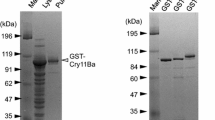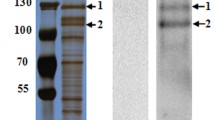Abstract
Cry1Ac δ-endotoxin produced by Bacillus thuringiensis (Bt) is used as a bio-pesticide for the control of Helicoverpa armigera. Aminopeptidases N (APN) and alkaline phosphatase (ALP) play critical roles in its action against H. armigera larvae. The binding of Cry1Ac with brush border membrane vesicle (BBMV) proteins was increased with the larval development although the sensitivity of larvae to δ-endotoxins decreased. There was higher expression of ALP than APN in early instar larvae with a ~10-fold higher affinity of Cry1Ac towards ALP than to APN. Binding to a specific receptor is therefore more important for the insecticidal activity rather than overall binding to the BBMV proteins. ALP might play a major role in toxicity as compared to APN.




Similar content being viewed by others
References
Angelucci C, Barrett-Wilt GA, Hunt DF, Akhurst RJ, East PD, Gordon KH, Campbell PM (2008) Diversity of aminopeptidases, derived from four lepidopteran gene duplications, and polycalins expressed in the midgut of Helicoverpa armigera: identification of proteins binding the delta-endotoxin, Cry1Ac of Bacillus thuringiensis. Insect Biochem Mol Biol 38:685–696
Arenas I, Bravo A, Soberon M, Gomez I (2010) Role of alkaline phosphatase from Manduca sexta in the mechanism of action of Bacillus thuringiensis Cry1Ab toxin. J Biol Chem 285:12497–12503
Banks DJ, Jurat-Fuentes JL, Dean DH, Adang MJ (2001) Bacillus thuringiensis Cry1Ac and Cry1Fa delta-endotoxin binding to a novel 110 kDa aminopeptidase in Heliothis virescens is not N-acetylgalactosamine mediated. Insect Biochem Molec Biol 31:909–918
Bravo A, Gomez I, Conde J, Munoz-Garay C, Sanchez J, Miranda R, Zhuang M, Gill SS, Soberon M (2004) Oligomerization triggers binding of a Bacillus thuringiensis Cry1Ab pore-forming toxin to aminopeptidase N receptor leading to insertion into membrane micro domains. Biochim Biophys Acta 1667:38–46
Broderick NA, Raffa KF, Handelsman J (2006) Midgut bacteria required for Bacillus thuringiensis insecticidal activity. Proc Natl Acad Sci USA 103:15196–15199
Chaturvedi R, Bhakuni V, Tuli R (2000) The d-Endotoxin proteins accumulate in Escherichia coli as a protein ± DNA complex that can be dissociated by hydrophobic interaction chromatography. Protein Exp Purif 20:21–26
English L, Readdy TL (1989) Delta endotoxin inhibits a phosphatase inmidgut epithelialmembranes of Heliothis virescens. Insect Biochem 19:145–152
Fernandez LE, Aimanova KG, Gill SS, Bravo A, Sobero′n M (2006) A GPI anchored alkaline phosphatase is a functional midgut receptor of Cry11Aa toxin in Aedes aegypti larvae. Biochem J 394:77–84
Gill M, Ellar D (2002) Transgenic Drosophila reveals a functional in vivo receptor for the Bacillus thuringiensis toxin Cry1Ac1. Insect Mol Biol 11:619–625
Gomez I, Sánchez J, Miranda R, Bravo A, Soberon M (2002) Cadherin-like receptor binding facilitates proteolytic cleavage of helix alpha-1 in domain I and oligomer pre-pore formation of Bacillus thuringiensis Cry1Ab toxin. FEBS Lett 513:242–246
Gomez I, Pardo-Lopez L, Munoz-Garay C, Fernandez LE, Perez C, Sanchez J, Soberon M, Bravo A (2007) Role of receptor interaction in the mode of action of insecticidal Cry and Cyt toxins produced by Bacillus thuringiensis. Peptides 28:169–173
Griko N, Zhang X, Ibrahim M, Midboe EG, Bulla L A Jr (2008) Susceptibility of Manduca sexta to Cry1Ab toxin of Bacillus thuringiensis correlates directly to developmental expression of the cadherin receptor BT-R1. Comp Biochem Physiol Biochem Mol Biol 151:59–63
Hofmann C, Vanderbruggen H, Heofte H, Van Rie J, Jansens S, Van Mellaert H (1988) Specificity of Bacillus thuringiensis delta-endotoxins is correlated with the presence of high-affinity binding sites in the brush border membrane of target insect midguts. Proc Natl Acad Sci USA 85:7844–7848
Hua G, Zhang R, Bayyareddy K, Adang MJ (2009) Anopheles gambiae alkaline phosphatase is a functional receptor of Bacillus thuringiensis jegathesan Cry11Ba toxin. Biochemistry 48:9785–9793
Ingle SS, Trivedi N, Prasad R, Kuruvilla J, Rao KK, Chhatpar HS (2001) Aminopeptidase-N from the Helicoverpa armigera (Hubner) brush border membrane vesicles as a receptor of Bacillus thuringiensis Cry1Ac d-endotoxin. Curr Microbiol 43:255–259
Jenkins JL, Lee MK, Sangadala S, Adang MJ, Dean DH (1999) Binding of Bacillus thuringiensis Cry1Ac toxin to Manduca sexta aminopeptidase-N receptor is not directly related to toxicity. FEBS Lett 462:373–376
Jurat-Fuentes JL, Adang MJ (2001) Importance of Cry1 delta-endotoxin domain II loops for binding specificity in Heliothis virescens (L.). Appl Environ Microbiol 67:323–329
Jurat-Fuentes JL, Adang MJ (2004) Characterization of a Cry1Ac-receptor alkaline phosphatase in susceptible and resistant Heliothis virescens larvae. Euro J Biochem 271:3127–3135
Jurat-Fuentes JL, Adang MJ (2007) A proteomic approach to study Cry1Ac binding proteins and their alterations in resistant Heliothis virescens larvae. J Invertebr Pathol 95:187–191
Jurat-Fuentes JL, Gould FL, Adang MJ (2002) Altered Glycosylation of 63- and 68-kilodalton microvillar proteins in Heliothis virescens correlates with reduced Cry1 toxin binding, decreased pore formation, and increased resistance to Bacillus thuringiensis Cry1 toxins. Appl Environ Microbiol 68:5711–5717
Knight PJ K, Crickmore N, Ellar DJ (1994) The receptor for Bacillus-Thuringiensis Cryla(C) delta-endotoxin in the brush-border membrane of the Lepidopteran Manduca sexta is aminopeptidase-N. Mol Microbiol 11:429–436
Krishnamoorthy M, Jurat-Fuentes JL, McNall RJ, Andacht T, Adang MJ (2007) Identification of novel Cry1Ac binding proteins in midgut membranes from Heliothis virescens using proteomic analyses. Insect Biochem Mol Biol 37:189–201
Lowry OH, Roberts NR, Wu ML, Hixton WS, Crawford EJ (1954) The quantitative histochemistry of brain II. Enzyme measurements. J Biol Chem 207:19–37
Luo K, Sangadala S, Masson L, Mazza A, Brousseau R, Adang MJ (1997) The Heliothis virescens 170 kDa aminopeptidase functions as “receptor A” by mediating specific Bacillus thuringiensis Cry1A delta-endotoxin binding and pore formation. Insect Biochem Mol Biol 27:735–743
Martins ES, Monnerat RG, Queiroz PR, Dumas VF, Braz SV, De Souza ARW, Gomes AC, Sánchez J, Bravo A, Ribeiro BM (2010) Midgut GPI-anchored proteins with alkaline phosphatase activity from the cotton boll weevil (Anthonomus grandis) can be the putative receptors for the Cry1B protein of Bacillus thuringiensis. Insect Biochem Mol Biol 40:138–145
McNall RJ, Adang MJ (2003) Identification of novel Bacillus thuringiensis Cry1Ac binding proteins in Manduca sexta midgut through proteomic analysis. Insect Biochem Mol Biol 33:999–1010
Mitz M, Schlueter R (1958) Direct spectrophotometric measurement of the peptide bond: application to the determination of acylase. Biochim Biophys Acta 27:168
Oltean DI, Pullikuth AK, Lee HK, Gill SS (1999) Partial purification and characterization of Bacillus thuringiensis Cry1A toxin receptor A from Heliothis virescens and cloning of the corresponding cDNA. Appl Environ Microbiol 65:4760–4766
Sangadala S, Walters FS, English LH, Adang MJ (1994) A mixture of Manduca sexta aminopeptidase and phosphatase enhances Bacillus thuringiensis insecticidal CryIA(c) toxin binding and 86Rb(+)-K+efflux in vitro. J Biol Chem 269:10088–10092
Sarkar A, Hess D, Mondal HA, Banerjee S, Sharma HC, Das S (2009) Homodimeric alkaline phosphatase located at Helicoverpa armigera midgut, a putative receptor of Cry1ac contains α-GalNAc in terminal glycan structure as interactive epitope. J Proteome Res 8:1838–1848
Schnepf E, Crickmore N, Van Rie J, Lereclus D, Baum J, Feitelson J, Zeigler DR, Dean DH (1998) Bacillus thuringiensis and its pesticidal crystal proteins. Microbiol Mol Biol Rev 62:775–806
Schwartz JL, Lu YJ, Sohnlein P, Brousseau R, Laprade R, Masson L, Adang MJ (1997) On channels formed in planar lipid bilayers by Bacillus thuringiensis toxins in the presence of Manduca sexta midgut receptors. FEBS Lett 412:270–276
Takesue Y, Yokota K, Miyajima K, Taguchi R, Ikezawa H (1989) Membrane anchors of alkaline phosphatase and trehalase associated with the plasma membrane of larval midgut epithelial cells of the silkworm, Bombyx mori. J Biochem 105:998–1001
Tuli R, Saluja J, Notani NK (1989) Cloning and expression in Escherichia coli of entomotoxic protein gene from Bacillus thuringiensis subspecies kurstaki. J Genet 68:147–160
Upadhyay SK, Mishra M, Singh H, Ranjan A, Chandrashekar K, Verma PC, Singh PK, Tuli R (2010) Interaction of Allium sativum leaf agglutinin (ASAL) with midgut brush border membrane vesicle proteins and its stability in Helicoverpa armigera. Proteomics 10:4431–4440
Van Rie J, Jansens S, Heofte H, Degheele D, Van Mellaert H (1989) Specificity of Bacillus thuringiensis delta-endotoxins. Importance of specific receptors on the brush border membrane of the mid-gut of target insects. Eur J Biochem 186:239–247
Van Rie J, Jansens S, Hofte H, Degheele D, Van Mellaert H (1990) Receptors on the brush border membrane of the insect midgut as determinants of the specificity of Bacillus thuringiensis delta-endotoxins. Appl Environ Microbiol 56:1378–1385
Whalon ME, Wingerd BA (2003) Bt: mode of action and use. Arch Insect Biochem Physiol 54:200–211
Wolfersberger MG, Luthy P, Maurer A, Parenti P, Sacchi VF, Giordana B, Hanozet GM (1987) Preparation and partial characterization of amino acid transporting brush border membrane vesicles from the larval midgut of the cabbage butterfly (Pieris brassicae). Comp Biochem Physiol 86:3001–3008
You TH, Lee MK, Jenkins JL, Alzate O, Dean DH (2008) Blocking binding of Bacillus thuringiensis Cry1Aa to Bombyx mori cadherin receptor results in only a minor reduction of toxicity. BMC Biochem 9:3
Zhang X, Candas M, Griko NB, Rose-Young L, Bulla L A Jr (2005) Cytotoxicity of Bacillus thuringiensis Cry1Ab toxin depends on specific binding of the toxin to the cadherin receptor BT-R1 expressed in insect cells. Cell Death Differ 12:1407–1416
Zhang R, Hua G, Andacht TM, Adang MJ (2008) A 106-kDa aminopeptidase is a putative receptor for Bacillus thuringiensis Cry11Ba toxin in the mosquito Anopheles gambiae. Biochemistry 47:11263–11272
Acknowledgment
Authors are grateful to the Council of Scientific and Industrial Research, Government of India, New Millennium Technology Leadership Initiative (NMITLI) program for the financial support. SKU is thankful to CSIR for senior research fellowship and G B Technical University, Lucknow, UP, India for Ph.D. registration.
Author information
Authors and Affiliations
Corresponding author
Electronic supplementary material
Below is the link to the electronic supplementary material.
Rights and permissions
About this article
Cite this article
Upadhyay, S.K., Singh, P.K. Role of alkaline phosphatase in insecticidal action of Cry1Ac against Helicoverpa armigera larvae. Biotechnol Lett 33, 2027–2036 (2011). https://doi.org/10.1007/s10529-011-0665-x
Received:
Accepted:
Published:
Issue Date:
DOI: https://doi.org/10.1007/s10529-011-0665-x




